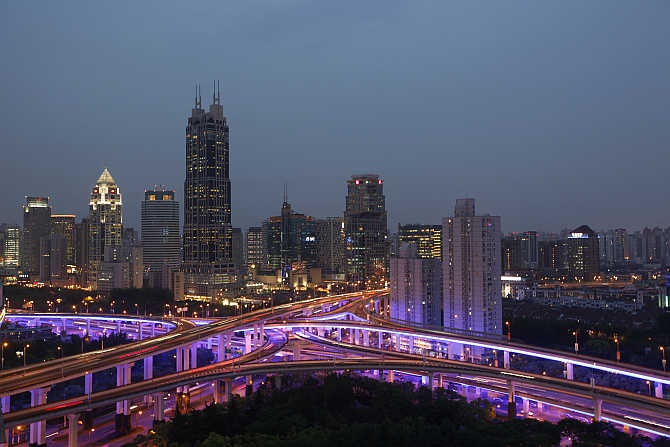Photographs: Mukesh Gupta/Reuters Akash Prakash
Most investors refuse to acknowledge India as a competitor to China, writes Akash Prakash.
Whenever I meet investors around the world, the most pressing question is: what happened to India? This was an economy that grew at nearly eight per cent for an entire decade (2003-2013). So much was expected from it. It was supposed to prove to the world that even a noisy, chaotic and populous democracy could deliver high growth. It was seen as the answer to China and its authoritarian economic model.
Though everyone knew that India had certain institutional flaws, they were willing to cut it some slack in the hope that the country would succeed. Given all the hope and hype, it's not surprising that there is now so much disappointment with India. In meetings, I now have to defend our growth record and explain why five per cent growth is not the new normal for India.
Eighteen months ago, we would use charts explaining how India was about eight or 10 years behind China on most economic indicators, and thus was poised for an acceleration in demand across product categories. Today, however, most investors refuse to acknowledge India as a competitor to China. Any comparison is rubbished because we are seen as being incapable of execution.
...
The irony of India story
Image: An aerial view shows vehicles travelling on intersections at night in downtown Shanghai, China.Photographs: Aly Song/Reuters
To many investors, India does not seem to have a long-term strategic game plan, and the lurch towards populism is scary. Everyone is convinced that this is a largely self-inflicted problem. The great demographic dividend is seen by most as an upcoming demographic disaster, given India's inability to provide skills training to its people or to create jobs.
When we show charts detailing the productivity improvements possible in rural India as a result of increased penetration of roads and electrification, many investors question our capability to deliver such infrastructure improvements. Even as I try to defend the country and point out our still-undimmed long-term growth potential to a largely sceptical audience, I try to think what the root cause of our travails is.
I know we will point to policy paralysis, the global slowdown, lack of political will and interest in reforms, judicial activism and so on. These are serious problems, but the source of our travails goes back even further - when India was included in the BRIC group. The acronym was introduced by Goldman Sachs in 2003 to represent the four largest emerging market economies, which, it was believed, would make a disproportionate impact on incremental global growth in the coming decades.
...
The irony of India story
Image: Tourists take pictures with the Rodrigo de Freitas Lagoon in the background in Rio de Janeiro, Brazil.Photographs: Ricardo Moraes/Reuters
It included Brazil, Russia, India and China. India was shown as being the country with the best long-term growth potential of the four, and one where growth would remain robust for the longest period.
The acronym caught the imagination of investors and policy makers globally, and we suddenly had arrived. Comparisons between India and China became the norm, and investors began salivating over our ability to accelerate our economic growth and surpass China.
Funds were created based on this concept, and all the four economies received large capital inflows and global attention. The inevitability of the West's decline and Asia's rise was taken for granted.
Charts by the economic historian Angus Maddison showing that India and China accounted for 50 per cent of the global economy became a staple of Bric presentations. The inclusion of India in the Bric group, as well as the surge in global capital flows and attention that this brought, lulled the country's policy makers into complacency.
We started believing that we were the next big thing, and that we had a god-given right to grow at eight or nine per cent for decades. We ignored the lessons of economic history, which clearly show that few countries have actually been able to deliver this type of sustained high growth. We seemed to believe that even with no effort we were destined to join this select club.
...
The irony of India story
Image: A woman walks on the platform as a train arrives at Mayakovskaya metro station, which was built in 1938, in Moscow, Russia.Photographs: Lucy Nicholson/Reuters
Our political class seemed convinced that all the injustices of the past centuries would get corrected, and all that we had to do was sit tight and growth would magically accelerate. They even seemed right for a while; favourable global growth conditions and the tailwind of reforms did cause our growth to accelerate.
However, a great deal of effort was required to sustain this growth - serious reform, institutional adaptation, and the willingness to take some tough decisions, which could have caused short-term pain. It is here that we have been found lacking.
As we began to believe in our growth acceleration and in its permanence, we started putting in place spending programmes to utilise this revenue windfall - not once questioning what would happen if growth slowed. Even the Reserve Bank of India started believing that eight per cent was our trend growth rate and seven per cent was the lower boundary, stating that even during the global financial crisis we had not fallen below this number.
Many economies get stuck in the so-called middle-income trap, wherein institutional weaknesses prevent the realisation of an economy's full growth potential, which normally happens at a much higher level of income per capita (typically above $7,000-8,000 a year). India seems to have stalled at far lower levels of economic development.
...
The irony of India story
Image: Farmers transport watermelons on their camels on the banks of the river Ganges to sell at a market in Allahabad.Photographs: Jitendra Prakash/Reuters
This is largely due to complacency and an unwillingness to make structural improvements to our economy. I think the current growth slowdown, although harmful in terms of economic hardship, has at least shaken our policy makers out of their complacency.
No longer does anyone believe that we will grow at eight or nine per cent, irrespective of policy action. Everyone acknowledges that we don't have all the answers and that there are lessons to be learnt from other economies.
Therein lies an opportunity for India. Just when most people have given up on us and on our ability to make the economic course correction required to regain a strong growth trajectory, the odds of us making the necessary changes have never been higher. Irrespective of which government comes to power in 2014, I am confident that the changes required for us to regain our growth trajectory will be implemented.
Already, in the last six months, this government has begun to move on many policy initiatives, started clearing bottlenecks and has taken some long-pending decisions. However, such is the disillusionment with the political class that investors are not taking cognisance of this effort.
Ironically, belief in India's long-term growth outlook has never been weaker, but the chances that we will take the necessary steps to deliver that growth have never been stronger.







article